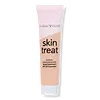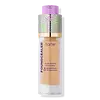Tarte Skin Treat Poreless Tinted Moisturizer SPF 20 Versus Tarte Foundcealer Multi-Tasking Foundation Broad Spectrum SPF 20
What's inside
What's inside
 Key Ingredients
Key Ingredients

 Benefits
Benefits

 Concerns
Concerns

 Ingredients Side-by-side
Ingredients Side-by-side

Titanium Dioxide 4.55%
Cosmetic ColorantZinc Oxide 3.5%
Cosmetic ColorantCyclopentasiloxane
EmollientIsododecane
EmollientMica
Cosmetic ColorantPolysilicone-11
Polymethylsilsesquioxane
Hexyl Laurate
EmollientPEG-10 Dimethicone
Skin ConditioningPolyglyceryl-4 Isostearate
EmulsifyingStearic Acid
CleansingCetyl PEG/PPG-10/1 Dimethicone
EmulsifyingAlumina
AbrasiveDipalmitoyl Hydroxyproline
Skin ConditioningTriethoxycaprylylsilane
Diamond Powder
AbrasiveIron Oxides
Titanium Dioxide 4.55%, Zinc Oxide 3.5%, Cyclopentasiloxane, Isododecane, Mica, Polysilicone-11, Polymethylsilsesquioxane, Hexyl Laurate, PEG-10 Dimethicone, Polyglyceryl-4 Isostearate, Stearic Acid, Cetyl PEG/PPG-10/1 Dimethicone, Alumina, Dipalmitoyl Hydroxyproline, Triethoxycaprylylsilane, Diamond Powder, Iron Oxides
Titanium Dioxide 7.47%
Cosmetic ColorantZinc Oxide 4.75%
Cosmetic ColorantWater
Skin ConditioningPhenyl Trimethicone
Skin ConditioningButylene Glycol
HumectantDimethicone
EmollientButylene Glycol Dicaprylate/Dicaprate
EmollientButyloctyl Salicylate
Skin ConditioningCyclohexasiloxane
EmollientCetyl PEG/PPG-10/1 Dimethicone
EmulsifyingBis-Diglyceryl Polyacyladipate-2
EmollientAluminum Hydroxide
EmollientMethyl Methacrylate Crosspolymer
Orbignya Oleifera Seed Oil
EmollientPolypropylsilsesquioxane
Sodium Chloride
MaskingStearic Acid
CleansingPolyglyceryl-4 Isostearate
EmulsifyingHexyl Laurate
EmollientDimethicone/Vinyl Dimethicone Crosspolymer
Skin ConditioningCalcium Stearate
Cosmetic ColorantDisteardimonium Hectorite
StabilisingTriethoxycaprylylsilane
Sodium Benzoate
MaskingPotassium Sorbate
PreservativeTocopherol
AntioxidantPolyhydroxystearic Acid
EmulsifyingHelianthus Annuus Seed Oil
EmollientEthylhexyl Palmitate
EmollientIsopropyl Myristate
EmollientIsostearic Acid
CleansingLecithin
EmollientDisodium EDTA
Cyclopentasiloxane
EmollientPolyglyceryl-3 Polyricinoleate
EmulsifyingKaolin
AbrasiveCyclotetrasiloxane
EmollientPhenoxyethanol
PreservativeSodium Hyaluronate
HumectantEthylhexylglycerin
Skin ConditioningHydrolyzed Hyaluronic Acid
HumectantIron Oxides
Titanium Dioxide 7.47%, Zinc Oxide 4.75%, Water, Phenyl Trimethicone, Butylene Glycol, Dimethicone, Butylene Glycol Dicaprylate/Dicaprate, Butyloctyl Salicylate, Cyclohexasiloxane, Cetyl PEG/PPG-10/1 Dimethicone, Bis-Diglyceryl Polyacyladipate-2, Aluminum Hydroxide, Methyl Methacrylate Crosspolymer, Orbignya Oleifera Seed Oil, Polypropylsilsesquioxane, Sodium Chloride, Stearic Acid, Polyglyceryl-4 Isostearate, Hexyl Laurate, Dimethicone/Vinyl Dimethicone Crosspolymer, Calcium Stearate, Disteardimonium Hectorite, Triethoxycaprylylsilane, Sodium Benzoate, Potassium Sorbate, Tocopherol, Polyhydroxystearic Acid, Helianthus Annuus Seed Oil, Ethylhexyl Palmitate, Isopropyl Myristate, Isostearic Acid, Lecithin, Disodium EDTA, Cyclopentasiloxane, Polyglyceryl-3 Polyricinoleate, Kaolin, Cyclotetrasiloxane, Phenoxyethanol, Sodium Hyaluronate, Ethylhexylglycerin, Hydrolyzed Hyaluronic Acid, Iron Oxides
Ingredients Explained
These ingredients are found in both products.
Ingredients higher up in an ingredient list are typically present in a larger amount.
This ingredient is a high molecular weight silicone. It has emulsifying and skin conditioning properties.
Cyclopentasiloxane, or D5, is a silicone used to improve texture of products and trap moisture.
D5 is considered lightweight and volatile. Volatile means it evaporates quickly after application. Once evaporated, D5 leaves a thin barrier that helps keep skin hydrated.
It is also an emollient. Emollients help soften the skin and prevent water loss. Silicones create a silky texture in products. D5 helps other ingredients become more spreadable.
Studies show D5 is safe to use in skincare products. We recommend speaking with a skincare professional if you have concerns.
Learn more about CyclopentasiloxaneHexyl Laurate isn't fungal acne safe.
This ingredient is an emulsifer and stabilizer. It comes from isostearic acid and polyglycerin.
As an emulsifier, it helps blend oil and water to improve texture, spreadbility, and application.
Due to it being derived from isostearic acid, this ingredient may not be fungal acne safe.
Learn more about Polyglyceryl-4 IsostearateStearic Acid is a fatty acid. It is an emollient, emulsifier, and texture enhancer.
As an emollient, stearic acid helps soften skin. It aids the skin's protective barrier by preventing water loss. It also provides a gentle cleansing effect without stripping away natural oils.
Stearic acid may also be used to enhance the texture of products. It can add volume and stabilize ingredients such as water and oil. This can help water and oil ingredients from separating.
Sources of stearic acid include animal or vegetable fats/oils such as coconut or shea. It can be naturally found in butter, cocoa butter, shea butter, vegetable fats, and animal tallow.
This ingredient may not be Malassezia folliculitis, or fungal-acne safe.
Learn more about Stearic AcidTitanium dioxide is a mineral UV filter widely used in sunscreens and cosmetics.
It is one of only two UV filters officially classified as “mineral” by regulatory agencies, the other being zinc oxide.
Titanium dioxide provides broad-spectrum protection mostly in the UVB and UVAII range, with some protection in the UVAI range.
While its UVA protection isn’t as strong as zinc oxide’s, the difference is minor.
A common myth is that mineral UV filters reflect UV light. However, modern research shows titanium dioxide absorbs UV radiation like chemical filters (~95% absorption & 5% reflection).
Thanks to its non-irritating nature, titanium dioxide is suitable for sensitive, acne-prone, or redness-prone skin. It is unlikely to cause "eye sting" like other sunscreen ingredients.
A major drawback of this ingredient is its white cast and thick texture. This is why mineral sunscreens often leave a white cast and are less cosmetically elegant than chemical/hybrid sunscreens.
To improve white cast and spreadability, micronized or nano-sized titanium dioxide is often used.
There are ongoing concerns surrounding nano-titanium oxide's impact on marine ecosystems.
There is no conclusive evidence that any form of titanium oxide (or any other sunscreen ingredients) will cause harm to marine ecosystems or coral reefs. The science is still developing but many consumers are keeping a close eye on this issue.
Please note, many destinations have reef-safety sunscreen rules. For instance, the U.S. Virgin Islands advises all visitors to use non-nano mineral sunscreens.
Nano mineral sunscreens once raised safety concerns about absorption into skin.
Extensive research has shown that they do not penetrate healthy or damaged skin; they remain safely on the surface and the top layer of dead skin (stratum corneum).
You'll likely find titanium dioxide bundled with alumina, silica, or dimethicone. These ingredients help make titanium dioxide highly photostable; this prevents it from interacting with other formula components under UV light.
Learn more about Titanium DioxideTriethoxycaprylylsilane is a silicone used to bind and stabilize ingredients.
As an emulsifier, it helps prevent ingredients from separating. This can help elongate the shelf life of products.
Triethoxycaprylylsilane is often used to coat mineral sunscreens ingredients to help give a better feel. It also helps reduce oxidative stress in sunscreens.
Learn more about TriethoxycaprylylsilaneZinc Oxide is a mineral broad-spectrum UV filter; it is the broadest UVA and UVB reflector approved by the FDA. It also has skin protectant and skin soothing properties.
Zinc oxide is one of the most effective broad-spectrum UV filters. It protects against UVB, UVAII, and UVAI. In comparison to its counterpart titanium dioxide, zinc oxide provides uniform and extended UVA protection.
Another great benefit? This ingredient is highly photostable so it won't degrade easily under sunlight.
A common myth is that mineral UV filters are widely believed to primarily reflect UV light.
However, modern research shows titanium dioxide absorbs UV radiation like chemical filters (~95% absorption & 5% reflection).
Zinc oxide has great skin soothing properties so you'll likely find this in sunscreens formulated for sensitive skin or babies/children. It is unlikely to cause "eye sting" like other sunscreen ingredients.
Regulatory agencies consider zinc oxide to be non-toxic and safe. It has also been shown to not penetrate the skin.
Unfortunately, this ingredient does leave a visible white cast. This is why mineral sunscreens are often less cosmetically elegant than chemical or hybrid ones.
In cosmetics, zinc oxide can be found in both non-nano and nano-sized forms. The nano version is used to reduce white cast and improve the texture of sunscreen formulas.
There are ongoing concerns surrounding nano-zinc oxide's impact on marine ecosystems and whether it can be absorbed into skin.
Regarding marine ecosystems and coral reefs, there is no conclusive evidence that any form of zinc oxide (or any other sunscreen ingredients) will cause harm. The science is still developing but many consumers are keeping a close eye on this issue.
Please note, many destinations have reef-safety sunscreen rules. For instance, the U.S. Virgin Islands advises all visitors to use non-nano mineral sunscreens.
There has also been some stir about whether micronized or nano zinc oxide has potential photoxicity and absorption through the skin/lungs.
An in-vitro (done in a test tube or petri dish) study demonstrated micronized zinc oxide to have potential phototoxicity. There's no need to fret; the EU Commission's Scientific Committee on Consumer Safety has stated, "The relevance of these findings needs to be clarified by appropriate investigations in vivo." Or in other words, further studies done on living organisms are needed to prove this.
Current research shows zinc oxide nanoparticles do not penetrate intact or sunburned skin. They either remain on the surface or in the outermost layer of dead skin (stratum corneum).
Zinc oxide is one of only two classified mineral UV filters with titanium dioxide being the other one.
Fun fact: Zinc has been used throughout history as an ingredient in paint and medicine. An Indian text from 500BC is believed to list zinc oxide as a salve for open wound. The Ancient Greek physician Dioscorides has also mentioned the use of zinc as an ointment in 1AD.
Learn more about Zinc OxideThis ingredient is a combination of red, black, and yellow iron oxide pigments. This combination of colors is usually found in foundation, because it results in a "skin" color.